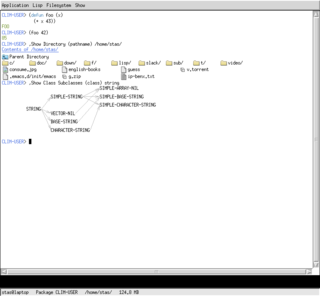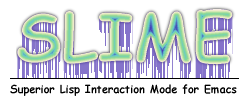Related Research Articles
Common Lisp (CL) is a dialect of the Lisp programming language, published in ANSI standard document ANSI INCITS 226-1994 (R2004). The Common Lisp HyperSpec, a hyperlinked HTML version, has been derived from the ANSI Common Lisp standard.
Emacs Lisp is a dialect of the Lisp programming language used as a scripting language by Emacs. It is used for implementing most of the editing functionality built into Emacs, the remainder being written in C, as is the Lisp interpreter. Emacs Lisp is also termed Elisp, although there is also an older, unrelated Lisp dialect with that name.

Lisp is a family of programming languages with a long history and a distinctive, fully parenthesized prefix notation. Originally specified in 1958, Lisp is the second-oldest high-level programming language in widespread use today. Only Fortran is older, by one year. Lisp has changed since its early days, and many dialects have existed over its history. Today, the best-known general-purpose Lisp dialects are Racket, Common Lisp, Scheme and Clojure.

Lisp machines are general-purpose computers designed to efficiently run Lisp as their main software and programming language, usually via hardware support. They are an example of a high-level language computer architecture, and in a sense, they were the first commercial single-user workstations. Despite being modest in number, Lisp machines commercially pioneered many now-commonplace technologies, including effective garbage collection, laser printing, windowing systems, computer mice, high-resolution bit-mapped raster graphics, computer graphic rendering, and networking innovations such as Chaosnet. Several firms built and sold Lisp machines in the 1980s: Symbolics, Lisp Machines Incorporated, Texas Instruments, and Xerox. The operating systems were written in Lisp Machine Lisp, Interlisp (Xerox), and later partly in Common Lisp.
Scheme is a minimalist dialect of the Lisp family of programming languages. Scheme consists of a small standard core with powerful tools for language extension.
In computer science, a preprocessor is a program that processes its input data to produce output that is used as input to another program. The output is said to be a preprocessed form of the input data, which is often used by some subsequent programs like compilers. The amount and kind of processing done depends on the nature of the preprocessor; some preprocessors are only capable of performing relatively simple textual substitutions and macro expansions, while others have the power of full-fledged programming languages.

The Common Lisp Object System (CLOS) is the facility for object-oriented programming which is part of ANSI Common Lisp. CLOS is a powerful dynamic object system which differs radically from the OOP facilities found in more static languages such as C++ or Java. CLOS was inspired by earlier Lisp object systems such as MIT Flavors and CommonLoops, although it is more general than either. Originally proposed as an add-on, CLOS was adopted as part of the ANSI standard for Common Lisp and has been adapted into other Lisp dialects such as EuLisp or Emacs Lisp.
CMUCL is a free Common Lisp implementation, originally developed at Carnegie Mellon University.
Greenspun's tenth rule of programming is an aphorism in computer programming and especially programming language circles that states:
Any sufficiently complicated C or Fortran program contains an ad hoc, informally-specified, bug-ridden, slow implementation of half of Common Lisp.
Embeddable Common Lisp (ECL) is a small implementation of the ANSI Common Lisp programming language that can be used stand-alone or embedded in extant applications written in C. It creates OS-native executables and libraries from Common Lisp code, and runs on most platforms that support a C compiler. The ECL runtime is a dynamically loadable library for use by applications. It is distributed as free and open-source software under a GNU Lesser Public License (LGPL) 2.1+.
A read–eval–print loop (REPL), also termed an interactive toplevel or language shell, is a simple interactive computer programming environment that takes single user inputs, executes them, and returns the result to the user; a program written in a REPL environment is executed piecewise. The term is usually used to refer to programming interfaces similar to the classic Lisp machine interactive environment. Common examples include command line shells and similar environments for programming languages, and the technique is very characteristic of scripting languages.

Steel Bank Common Lisp (SBCL) is a free Common Lisp implementation that features a high-performance native compiler, Unicode support and threading.

StumpWM is a tiling window manager that was created when developer Shawn Betts found ratpoison growing increasingly large and "lispy". Intended as a successor to ratpoison, StumpWM is released under the terms of the GNU General Public License, version 2 (GPLv2).

The Common Lisp Interface Manager (CLIM) is a Common Lisp-based programming interface for creating user interfaces, i.e., graphical user interfaces (GUIs). It provides an application programming interface (API) to user interface facilities for the programming language Lisp. It is a fully object-oriented programming user interface management system, using the Common Lisp Object System (CLOS) and is based on the mechanism of stream input and output. There are also facilities for output device independence. It is descended from the GUI system Dynamic Windows of Symbolics' Lisp machines between 1988 and 1993.
... you can check out Common Lisp Interface Manager (CLIM). A descendant of the Symbolics Lisp machines GUI framework, CLIM is powerful but complex. Although many commercial Common Lisp implementations actually support it, it doesn't seem to have seen a lot of use. But in the past couple years, an open-source implementation of CLIM, McCLIM – now hosted at Common-Lisp.net – has been picking up steam lately, so we may be on the verge of a CLIM renaissance. – From Practical Common Lisp

SLIME, the Superior Lisp Interaction Mode for Emacs, is an Emacs mode for developing Common Lisp applications. SLIME originates in an Emacs mode called SLIM written by Eric Marsden. It is developed as an open-source public domain software project by Luke Gorrie and Helmut Eller. Over 100 Lisp developers have contributed code to SLIME since the project was started in 2003. SLIME uses a backend called Swank that is loaded into Common Lisp.
New Implementation of LISP (NIL) is a programming language, a dialect of the language Lisp, developed at the Massachusetts Institute of Technology (MIT) during the 1970s, and intended to be the successor to the language Maclisp. It is a 32-bit implementation, and was in part a response to Digital Equipment Corporation's (DEC) VAX computer. The project was headed by Jon L White, with a stated goal of maintaining compatibility with MacLisp while fixing many of its problems.
PC-LISP is an implementation of the Franz Lisp dialect by Peter Ashwood-Smith.
The Sound Object (SndObj) Library is a C++ object-oriented programming library for music and audio development. It is composed of 100+ classes for signal processing, audio, MIDI and file I/O and is available, cross-platform, for Linux, Windows, Mac OS X, IRIX and other Unix-like systems.
In functional programming, filter is a higher-order function that processes a data structure in some order to produce a new data structure containing exactly those elements of the original data structure for which a given predicate returns the boolean value true.
A symbol in computer programming is a primitive data type whose instances have a unique human-readable form. Symbols can be used as identifiers. In some programming languages, they are called atoms. Uniqueness is enforced by holding them in a symbol table. The most common use of symbols by programmers is for performing language reflection, and most common indirectly is their use to create object linkages.